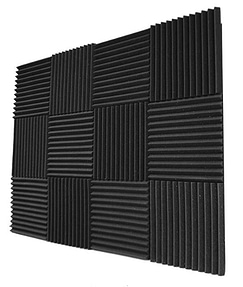You might have covered every wall, every window, and door, but you still won’t get respite from the loud violinist upstairs or the bawling toddler right below you. Sound can penetrate quite well through ceilings and floors, so you must reinforce them adequately to keep your space absolutely noise-free. Here we will list a few ways to soundproof your ceiling and floor:
Table of Contents
Install Soundproof Drywall
Rather than the normal drywall (made of gypsum and paper), using soundproof drywall is much better as it is thicker, denser, and better at reducing impact noise or airborne noise. However, this option is on the costlier side as a small drywall area costs $40 onward.
Use Acoustic Tiles
However, if you have reservations about using these boards, soundproofing foam panels may be a better alternative. They’re lighter and easier to work with but are just one step in the process.
Soundproof ceiling tiles are very good at absorbing sound. They can be hung using a metal frame, attached using special clips, or pasted over the regular ceiling with industrial adhesive. Although they’re not very easy to put up, their designs are much better and aesthetic.
Construct an Acoustic Hanger
Creating a hanging structure beneath the original ceiling can reduce noise coming through the air or impact. Soundbreaker bars are such hangers with a unique design, which absorb sound coming from above, and are meant to be stuck to the floating ceiling joists. Thus, they can also absorb any vibration. However, this method can only work if there is enough space between the ceiling and the floor, as you will lose about 6 inches.
Extra Layers
An extra layer of anything over your head can increase soundproofing. Another layer of drywall or another layer of fiberglass insulation on your joists ensures soundproofing ceiling impact noise and work really well in minimizing sound waves from traveling from one floor to another. This is a rather inexpensive and fairly easy method for you.
Acoustic foam panels

Acoustic foam panels are more effective at keeping the noise from going out through a wall than preventing noise from coming in through a wall.
These panels are primarily designed to absorb sound. If you want to use them effectively to block out sound, you will need to install them in the room that the noise is coming from.
If your neighbor is making noise, then these panels offer very little to you. If you plan to use these to block noise from coming in, then remember the wall can only be as effective at blocking out sound as its weakest point, meaning you will need to cover the wall entirely for any real benefits.
Imagine you’re using this method in your nursery. When your baby cries, the sound reflects off the flat hard surfaces in the room. This echo intensifies the sound, so it gets louder. Attaching foam panels to the walls (flat hard surfaces) prevents sound waves’ reflection, so the sound is reduced.
Acoustic Foam works the same way as acoustic tiles but are not of the same quality and are thus, more economical but easier to apply. The best acoustic foam panels don’t look very good on the ceilings but serve their purpose undoubtedly. Acoustic foam could be stuck using adhesive or nailed. You could also use them for the walls.
Covering with Acoustic Floor Underlayment
These materials can be placed underneath the flooring (tiles/carpet) and made of various substances. The higher the price, the better the soundproofing. They are sold in adhesive rolls and can be cut into pieces and nailed into the ground.
National Consumer Center offers you a chance to get a $500 gift card to Amazon. The payouts are quick, and you can use the Gift Card to pay for some of your Amazon products.
Using Mass Loaded Vinyl
You can fit a special substance under your flooring material; MLV is a very dense compound made of barium sulfate and vinyl. The best MLV kills all the noise coming from whatever lies beneath it, and the extra padding gives rise to genuine soundproof insulation.
Mass Loaded Vinyl (MLV) applications
Mass is a critical component in sound control and works by simply stopping sound from vibrating through its structure. Mass Loaded Vinyl (MLV) is an effective material to use in lining soundproofing curtains or blankets.
At even just ½LB per sq ft, MLV can produce a 25 STC rating, which is 1/16” thickness. You can get up to 35 STC by using 2lb per sq ft and 1/4” thickness; however, this is slightly more difficult to work with.
Putting Carpets and Rugs
Dense rugs, carpet padding, and interlocking mats are other inexpensive and easier options to reduce sound coming from downstairs temporarily. Special carpets and rugs, made of denser material, are available in the market for soundproofing. It’s easy to lie them on the floor and then nail them on the edges for a tautly carpeted floor.
Seal cracks and gaps around the frame
Air and sound may also leak through gaps around the frame, so sealing off this area is another “Must-do” step in the sound management process.
Caulking in a layer of Green-glue around the frame will effectively address this issue. A large caulking gun is needed, and applying to bead around the entire frame is recommended.
Once you have established an air-tight seal around the frame and there are no gaps around the frame itself, you can look at other areas to address.
Conclusion
These are some of the best methods to keep that nagging noise away from your room and get some peace. The permanent ones are recommended only if you have long-term accommodation and cash to spend; otherwise, the temporary fixes will suffice quite well, although not as good as the others.
Good luck and happy soundproofing!



2 comments
Comments are closed.